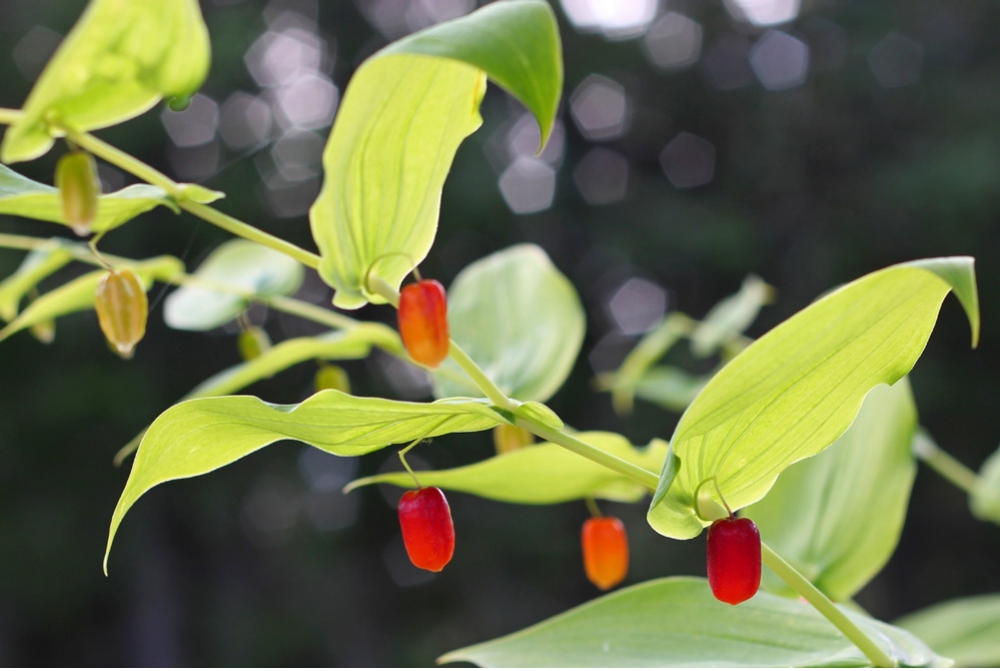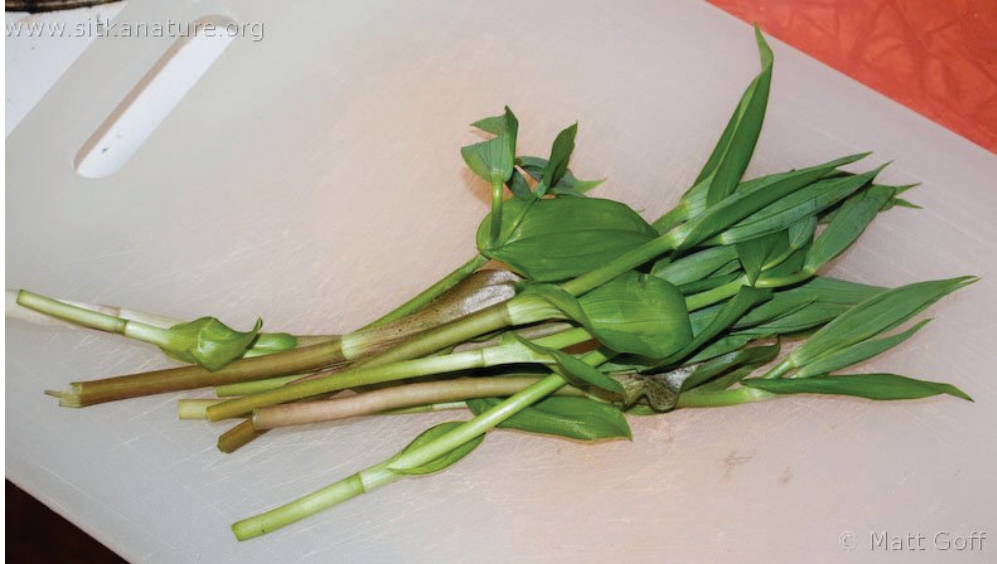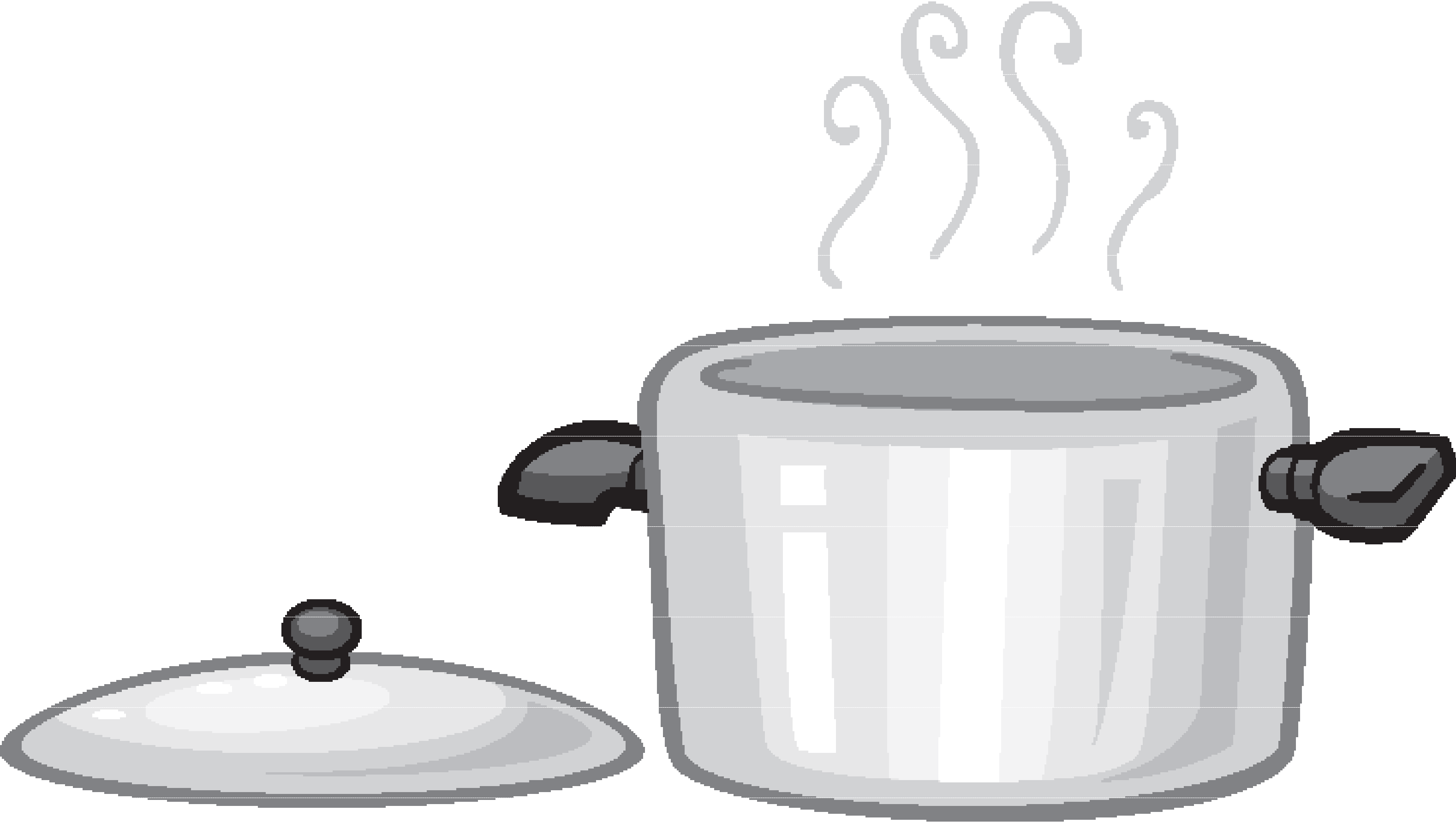Watermelon Berries
FNH-00123 View this publication in PDF form to print or download.
by Leslie Shallcross

Streptopus amplexifolius is a plant in the lily family, known in Alaska as “watermelon berry.” Other common names include “twisted stalk” and “wild cucumber.” The names may come from the unique “kinked” stalk that bears the berry, the cucumber flavor of the shoots and the watermelon flavor and color of the ripe fruit. Streptopus species prefer cool, shady and damp growing conditions and can be found throughout the continental United States and Canada. Watermelon berries are common in Alaska along the coast from Southeast Alaska north to the central Yukon River area at Manley Hot Springs and in damp wooded areas of Interior Alaska.
The plants grow from 1 to 3½ feet high and have branching stems. The oval leaves are 2 to 5 inches long, broadest toward the base, and grow in an alternate pattern. Flowers are bell-shaped, pinkish or greenish, and hang from a slender stalk in the axil of the leaves. Ripe watermelon berries are slightly oblong, very juicy and are light to deep red, although some varieties produce yellowish-white or orange berries. The shoots may be confused with two other lily family plants that may occasionally be found in similar habitats — false Solomon’s seal and false hellebore. The latter of these, false hellebore, is poisonous, so positive identification is necessary before using roots, stems, leaves or berries.
In the spring, Alaskans enjoy and prize the young, tender shoots of the plant for their fresh cucumber-like flavor. The shoots can be eaten in salads or cooked with other fresh greens. Perfectly ripe, plump berries have a lightly sweet watermelon-like flavor and make excellent jelly, syrups and juice. They can also be used as an extender with other berries. Though it is tempting to eat all the berries while picking, watermelon berries contain seeds that are reputed to be somewhat laxative, and some allergies to this berry have been reported, so use caution when trying them for the first time.
Storage and Preservation
How to Clean and Store
Wash watermelon berries very carefully in a colander to rinse off the dust and bugs, and store in a covered container in the refrigerator for no longer than two to three days.
How to Freeze
To freeze watermelon berries, arrange dry, fresh berries in one layer on a cookie sheet and place in the freezer. When frozen, transfer berries to freezer bags or containers. Properly frozen, watermelon berries will last up to two years.
How to Dry
Because of their high moisture content and large seeds, watermelon berries are not suitable for drying.
How to Extract Juice
Combine 4 cups of cleaned watermelon berries with 1 cup of water. Crush berries. Bring to a simmer, cover and simmer for 10 minutes. Strain through a jelly bag or several layers of cheesecloth in a colander. Let the juice drip into a bowl. For clear juice, do not twist or press jelly bag or cheesecloth. For long-term storage, the juice should be frozen.
Yield: 3 cups
Hot pack for juice
Sterilize canning jars. Heat juice, stirring occasionally, until it begins to boil. Pour into hot jars, leaving ¼ inch headspace. Wipe jar rims. Adjust lids. Process in a boiling water canner.
- Pints or quarts 5 minutes
How to Prepare Puree
Watermelon berries do not make a good puree because they are mostly juice and seeds with very little pulp.
- To sterilize canning jars, boil in water for 5 minutes.
- To prepare two-piece lids (rings and tops), wash, rinse set aside until ready to use. Follow manufacturer’s directions for use.
- If less sugar is desired in recipes calling for pectin, be sure to use no-sugar-needed pectin and follow the instructions on the box.
- See later instructions on this page for how to use a boiling water canner.

Recipes
Watermelon Berry Syrup
- 1 cup watermelon berry juice
- 2 cups sugar
- 1 teaspoon lemon juice
Combine all ingredients in a saucepan and heat to 160°F. Use a candy thermometer; do not boil. The syrup is ready to use over waffles, pancakes, hot biscuits, ice cream and other desserts. Syrup will keep up to six months in the refrigerator without sugaring.
For long-term storage: Sterilize pint or half-pint canning jars and prepare lids. Immediately pour hot syrup into hot canning jars, leaving ¼ inch headspace. Wipe jar rims and add prepared two-piece lids. Process 5 minutes in a boiling water canner.
Yield: 2 cups
Watermelon Berry Jelly
- 2¾ cups watermelon berry juice
- ¼ cup lemon juice
- 1 package powdered pectin (1¾ ounces)
- 4½ cups
Sterilize pint or half-pint canning jars and prepare lids. Measure sugar and set aside. Measure watermelon berry juice and lemon juice into a large saucepan. Add pectin and stir until dissolved. Place on high heat; stir constantly and bring to a full rolling boil that cannot be stirred down. Stir in 4½ cups of sugar all at once. Again, bring to a full rolling boil. Boil hard for 1 minute, stirring constantly. Remove from heat and quickly skim off foam. Immediately pour hot jelly into hot canning jars, leaving ¼ inch headspace. Wipe jars rims and add prepared two-piece lids. Process 5 minutes in a boiling water bath.
Yield: 5-6 cups
References
Pojar, Jim and Andy Mackinnon. 1994. Plants of the Pacific Northwest Coast: Washington, Oregon, British Columbia and Alaska. Vancouver: Lone Pine Publishing.
USDA Natural Resources Conservation Service Plants Database, http://plants.usda.gov/java/
UAF Cooperative Extension Service Resources
Jams and Jellies – Lesson 5, Food Preservation Series, FNH-00562E
Canning Overview – Lesson 2, Food Preservation Series, FHN-00562B
Using Alaska’s Wild Berries and Other Wild Edibles ($15), FNH-00120
Fruit Leather, FNH-00228
Canning Basics DVD ($5), FNH-01280
Jams and Jellies DVD ($5), FNH-01290
- Fill the canner halfway with water. Preheat water to a low boil. Place filled jars, fitted with lids, into the canner on the rack. Add more boiling water, if needed, so the water level is at least 1 inch above jar tops. Turn heat to its highest position until water boils vigorously. When the water boils, set a timer for the recommended processing time indicated in the recipe. Cover with the canner lid and lower heat setting to maintain a gentle boil throughout the processing time. Add more boiling water, if needed, to keep the water level above the jars.
- When the jars have been boiled for the recommended time, turn off the heat and remove the canner lid. Using a jar lifter, remove the jars and place them on a towel, leaving at least 1 inch of space between the jars during cooling.
- After cooling jars for 12 to 24 hours, remove the screw bands and test seals. Press the middle of the lid with a finger. If the lid springs up when finger is released, the lid is unsealed. If a lid fails to seal on a jar, remove the lid and check the jar-sealing surface for tiny nicks. If necessary, change the jar, add a new, properly prepared lid and reprocess within 24 hours using the same processing time. Alternately, adjust headspace to 1½ inches and freeze or store in the refrigerator and use within three days.
- If lids are tightly sealed on cooled jars, remove screw bands, wash the lid and jar
to remove food residue, then rinse and dry jars. Label and date the jars. Store
in a clean, cool, dark, dry place.

Leslie Shallcross, Extension Faculty, Health, Home and Family Development, and Marci Johnson, Program Assistant, Health, Home and Family Development
Revised February 2021
